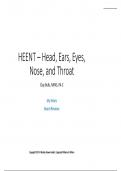HEENT – Head, Ears, Eyes,
Nose, and Throat
Clay Bulls, MPAS, PA-C
My Notes
Board Reviews
Copyright © 2014 Wolters Kluwer Health | Lippincott Williams & Wilkins
, HEENT Common or Concerning Symptoms?
Many symptoms of the head and neck reflect common, benign, or infectious processes.
Getting a good history is KEY in order to evaluate for a possible serious underlying etiology.
Head Headache, history of head injury, worst
headache of my life, “thunderclap”
Eyes Visual disturbances, spots (scotomas), flashing
lights, use of corrective lenses, pain, redness,
excessive tearing, double vision (diplopia), loss
of vision
Ears Hearing loss, ringing (tinnitus), vertigo, pain,
discharge
Nose Drainage (rhinorrhea), congestion, sneezing,
nose bleeds (epistaxis)
Oropharynx Sore throat, gum bleeding, hoarseness, sores
Neck Swollen glands, swelling, difficulty swallowing,
pain
Copyright © 2014 Wolters Kluwer Health | Lippincott Williams & Wilkins
, Health History- The Head
• Headache is one of the most • Every headache warrants careful
evaluation for life-threatening secondary
common complaints in clinical causes
practice (30% of general • Meningitis
• Subarachnoid hemorrhage
population) • Mass lesion
• Tension headaches are the most • 3 most important attributes of a
common, affecting half of all headache
individuals during their lifetime • Severity
• Headaches are classified as: • Chronologic pattern
• Associated symptoms
• Primary – without an underlying
disease • The quality of the Headaches can
• Tension, Migraine, Cluster also follow a pattern specific to your
• Secondary – with an identified patient (example, in migraines – aura,
underlying disease followed by increasing severity
throughout the day). New onset,
• Could be dangerous progressive, and severe headaches
should raise concern for tumor,
abscess, or mass lesions (hematoma,
abscess, primary neoplasm,
infarction)
Copyright © 2014 Wolters Kluwer Health | Lippincott Williams & Wilkins
, Headache Warning Signs
• Sudden onset “the worst headache • Aggravated or relieved by position
of my life!” or “thunderclap” change
• Sudden, thunderclap HA described as • Position change/Valsalva – leaning
“the worst headache in my life” occurs forward + Valsalva – worse in sinusitis;
in 70% of patients with subarachnoid Valsalva + lying down – worse in mass
hemorrhage lesion due to changing intracranial
pressure.
• Progressively frequent or severe over
a 3-month period • Recent head trauma
• New onset after age 50 • Associated visual changes, neck
stiffness, or focal neurologic deficits
• Associated with fever, night sweats,
or unintentional weight loss • Presence of cancer, HIV, or pregnancy
• Cancer: headache can be metastasis
• Change in pattern from previous
• Pregnancy is hard on body
headaches
• New onset HA over 50: • Precipitated by Valsalva or exertion
Subarachnoid hemorrhage, subdural
hematoma, intracerebral
hemorrhage, Giant cell arteritis,
mass lesion
Copyright © 2014 Wolters Kluwer Health | Lippincott Williams & Wilkins




